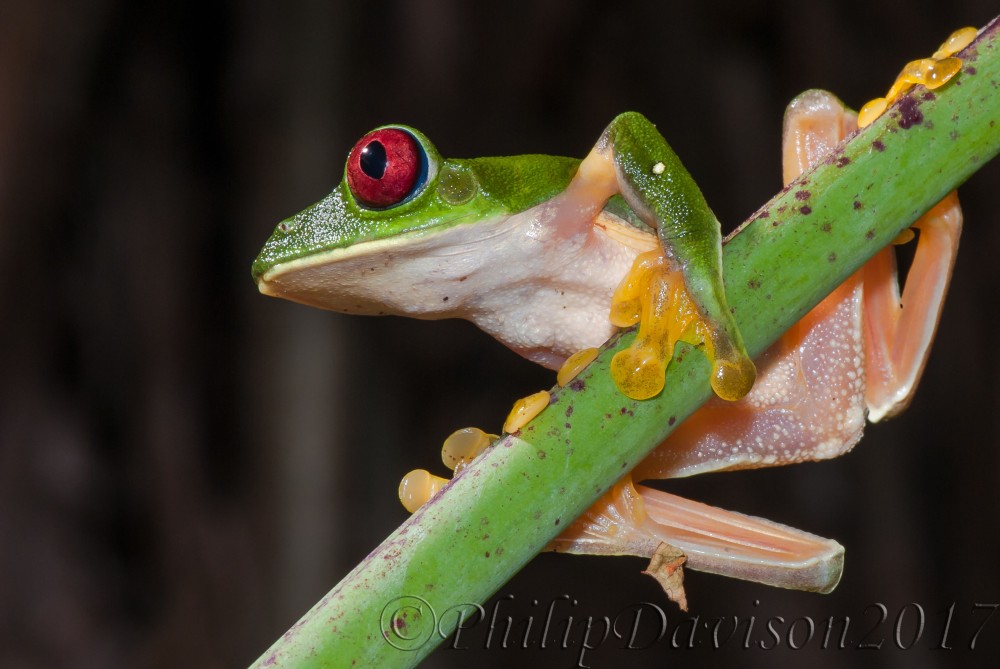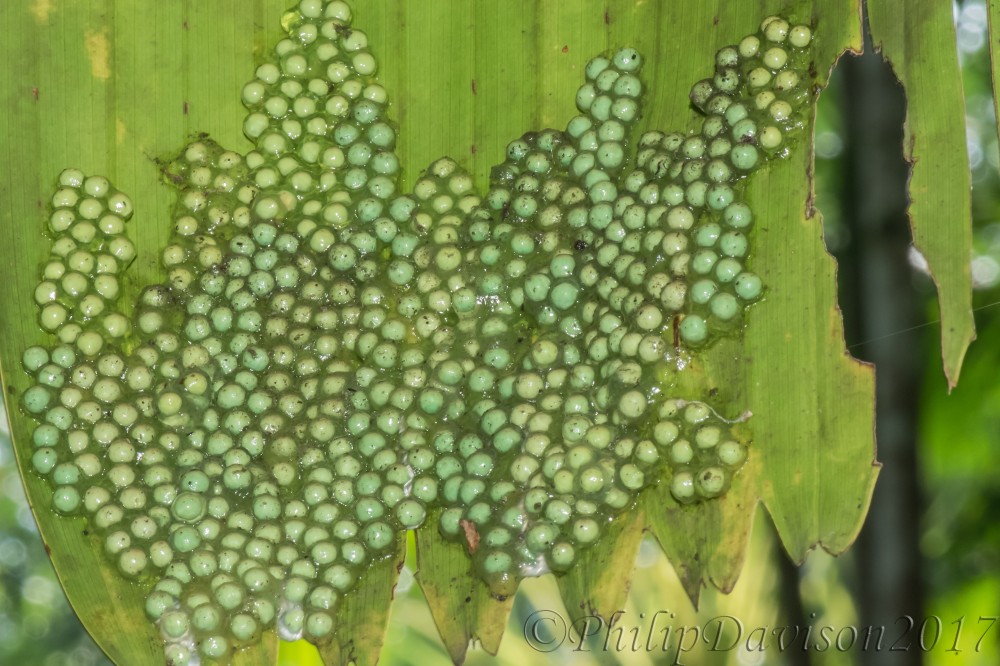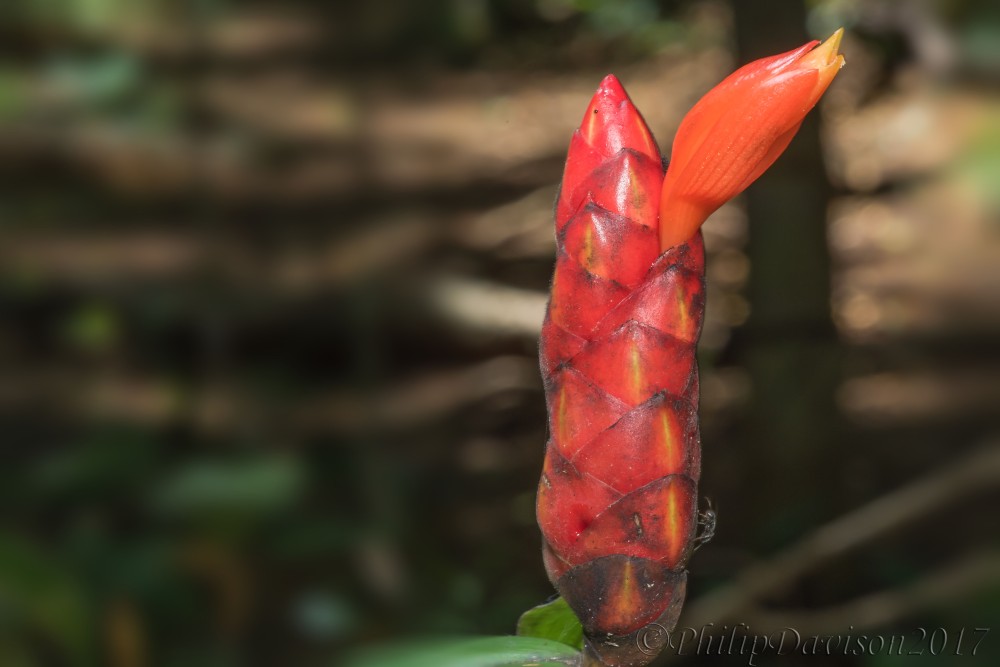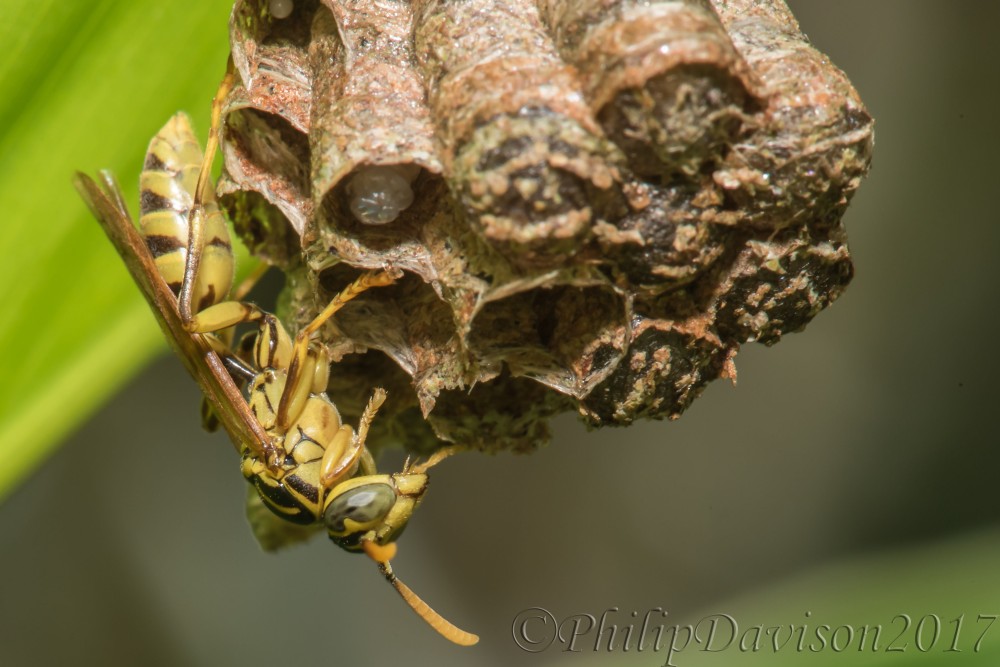
Parachuting into an Orgy
The past week has been a mixture of sun and rain. The days have been gloomy with heavy, brooding overcast skies. Occasionally the clouds part and the sun has shone down to light up the shadows. But the menacing grey blanket that covering the area from north to south and east to west always threatened to unleash a downpour. Sometimes the drizzle filled the air from dawn to dusk but you knew there was more to come. By late afternoon the light rain would turn to heavy and by the time the sun had set below the horizon then the heavens would open drenching one and all.
The amphibians have been enjoying the onset of the rainy season, their numbers increasing over the last month but these more persistent nightly deluges have had the frogs collecting in huge numbers and rejoicing in a reproductive frenzy. One frog that responds to torrential rain is the Parachuting Red-eyed Green Tree Frog, (Agalychnis spurrelli).

Parachuting Red-eyed Green Tree Frog, (Agalychnis spurrelli)
One evening, just after sunset it started to rain heavily and by next morning we had experienced 11 inches of rain. That was the trigger that stimulated hundreds of Parachuting Red-eyed Green Tree Frogs to leave the canopy, which is where they reside out of view, and launch themselves into the air. This frog has a uniformly colored dark mossy green upper side. Its flanks are a pale lemon yellow. It has large heavily webbed hands and feet of the same buttery hue and, of course, it has the large red eyes. As they leap out of the canopy they spread the fingers and toes so the webbing is stretched tight, quite literally into a parachute of living tissue, which allows the frogs to glide down to the vegetation surrounding the pond without ill effect.
Each male quickly establishes a territorial perch from which he begins to call in an attempt to entice an egg-laden female his way. The call is a short, soft, almost electronically-sounding sound. Selecting a male on the quality of his call, the deeper the sound the better, the female makes her way over to the chosen chorister, he jumps on her back and they set off to visit the pond. The female absorbs water through her skin and fills her bladder. Now the female, not only with a body full of eggs but also carrying the male on her back, makes her way to a deposition site. She chooses a broad leaf overhanging the surface of the pond and she commences to lay a sheet of eggs across the leaf. At the same time as she releases the eggs from her body the male fertilizes them. This normally take place just before daylight.

Parachuting Red-eyed Green Tree Frog Eggs.
As dawn breaks and the sun rises, the frogs have to get out of the light and into the dark as quickly as possible. They don’t have time to get back to the canopy, parachuting down was a quick descent but the ascent involves a 100 foot climb and there is little time. The sun continues to steadfastly climb in the sky. Hundreds of frogs are now scrambling desperately to escape the skin-drying effects of its harsh rays. This was the point at which I arrived, just in time to see countless small green goblinesque figures running along branches in a desperate effort to find a not already fully accommodated shelter. I was not the only one. A Bare-throated Tiger Heron had found itself an early morning breakfast bonanza and was picking off the unfortunate amphibians one after the other.
The larvae will develop in the eggs for about 7 or 8 days before the gelatinous mass liquidizes and the wiggling tadpoles drop into the pond water. There they will complete the tadpole stage and if they make it through the aquatic stage will finally emerge after 7 or 8 weeks as a tiny froglet which will eventually have to make its way to the tree tops. The Parachuting Red-eyed Green Tree Frog is an explosive breeder and these episodes can only be witnessed following those biblical-like rain storms.

Parachuting Red-eyed Green Tree Frogs After Sunrise
Showing Off in the Green Room
The forest flora can be flamboyant and gaudy or subtle and subdued. The blooms may appear abruptly in a visual feast or occur in small numbers isolated and hidden in the dark green depths the subcanopy. Some plants flower but once a year, a spectacular show drawing the eye like a beacon which is setting the tree tops ablaze and illuminating the forest canopy in a patchwork of color on natures silvian canvas. It is no wonder that the largest percentage of insect life resides and thrives at the tree tops. Here you will find a kaleidoscope of dancing butterflies waltzing from bloom to bloom in search of the energy rich nectar, so vital in allowing these ephemeral beauties to complete the final stage of their short adult lives. Other plants may flower continuously throughout the year but only producing one or two blooms at a time.
It is not just the butterflies that rely upon the flowers. Many other insects are attracted by their rich colors and evocative scents. The plants will sometimes target birds or mammals to do their bidding. The plants offer the animals rewards but there is method to their bribery. These are windless forests; a zephyr is the strongest a current of air that will move through the trees. Pollen needs to be transported from one plant to another in order for the plants to reproduce. It helps if the plant can target and reward a specific agent to enable its pollen to be deposited in the flower of the same species.
The plants cannot rely on wind for seed dispersal either. Once more they have evolved the means by which to encourage animals into becoming innocent vectors of transfer and movement of the seeds that will potentially give rise to the next generation.
Over the last week as I was walking along the paths through the forest I could see some of those secretive flowers blooming in the shadows as well as some bright vivid forms, their colorful flower heads breaking up the somber borders of the trails. One of the more subtle blooms was that of the Spiral Ginger, (Costus scaber). The flowering head is a rather stout, deep red spike composed of bracts, each of which will produce a bloom.

Spiral Ginger, (Costus scaber)
The fiery orange, yellow-tipped flower sticking out of the bract attracts in hummingbirds which are the principal pollinator of this species. The colors red, orange and yellow are commonly used by plants to attract hummingbirds, these being the colors in the spectrum that are complementary to the background green of the leaves. These are also very hot colors whereas green is a cool color and so they readily stand out, particularly to animals that have keen color vision such as birds. The hummingbirds hover in front of the flowers and probe within searching for the nectaries. As they do so, the head and bill pick up pollen from the anthers which is transferred to the stigma of the next flower it visits thereby effectively pollinating the plant.
The family Costaceae is closely related to the ginger family: Zingerberaceae. Most gingers are Asian but there are some gingers native to the Neotropics. Most costas are American but there are some costas that are native to Asia. There are 23 species of costa native to Costa Rica, 14 of which are found on the Osa Peninsula. As they all look similar it is not too hard to identify them as costas but it is a little more difficult to identify them to species level.
Queen of Pain
Insects are fascinating creatures to photograph. Once you have downloaded the image and zoom in, as long as the picture is in sharp focus, then the body form and colors become compelling. All of the joints, the body plates and the detail of the head and wings will keep the naturalist mesmerized. You can conjecture as to the function of all those different hairs and how the body parts articulate. Not only that but how does the creature live, what is life history and what are the multitudinous, complex interconnected threads that tie it into the ecosystem of its habitat. Insects complete their lives in almost as many ways as there are species. Many insect’s lives are a mystery to us, we simply have no idea how they get from egg to adult. That is not surprising as there are more species of insect on the planet than any other group of animals. Because we don’t know, then that makes us more eager to study and discover more information to unravel those mysteries.
One groups of animals, the Hymenoptera, bees, wasps and ants, provide an endless source of material for research. Many of them have well documented life histories and they work to a general pattern but there are variations. I saw this wasp guarding its brood in a nest under a leaf in the tropical garden.
Although the wasp appeared to be alone, it was one of the social wasps belonging to the family: Vespidae. The nest is made of carton which is a chewed up fibrous vegetable material, quite often wood, which forms the cells into which the eggs are laid. The egg hatches and the larva develops, growing rapidly on a diet of chewed up insect prey captured by the queen. The queen only uses her sting for defense, the prey is caught and chewed-up in the mandibles. A pale larva lacking in pigment, can be seen in one of the cells. When the larva pupates, the entrance of the cell is capped by a carton lid from which a new adult will emerge sometime later.

Paper Wasp Queen on Nest, (Polistinae sp)
There were, in fact, two wasps sitting on the nest. This suggests that they belong to the subfamily: Polistinae. These colonies consist of one or two queens both of which are responsible for the construction of the nest and raising the offspring without the aid of other workers.
Even if nobody told you, then you would learn very quickly from painful experience to leave wasps alone. The black and yellow coloration of bees, wasps and hornets is the most visible of all color combinations. As I have already mentioned, the wasp does not use its sting to subdue prey but rather uses it to defend itself. But, as in many cases, it is better to use a deterrent rather than become involved in a physical battle where even though you may win, the probability is that you will sustain some damage yourself. To ward off any potential threat, the wasps use threatening coloration. It does not take too many painful encounters before most creatures would learn to avoid anything sporting that vividly distinctive black and yellow.
Philip Davison Is a Biologist, Writer and Photographer Based in Costa Rica
Thanks Philip. Beautiful photos and interesting/telling writng.
I have done bungee jumping, zip lining and parapenting…. I think I’m ready to be a Parachuting Red-eyed Green Tree Frog, (Agalychnis spurrelli) minus the hungry heron. What a gorgeous amphibian and a great story to go with it. Hope to see you in later November : )
Fred
LikeLike
Take care when you jump out of a tree Fred, you might end up with red eyes. I know everyone would be looking forward to seeing you and Jen in November.
LikeLike
I find your posts so fascinating for their stories of the animal world, thank you for sharing your experiences with us.
LikeLike
Thanks Emily. It is always nice to know that people appreciate the posts and find the natural world as fascinating as I do.
LikeLike
I usually ignore emails with the word “orgy” in the subject. 😉
But, this one was worth reading as usual. I love the picture of the tree frogs all massed together. It’s fascinating how their reproductive process works.
LikeLike
I find it fascinating Alan that the environmental trigger acts so precisely and effectively upon hundreds of frogs all at once. What is the threshold level that stimulates that mass response. It is also a surprise as to just how many frogs are there, living unseen in the tree tops.
LikeLike